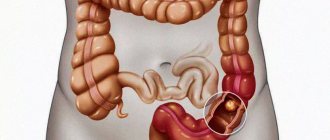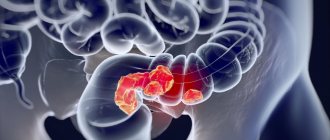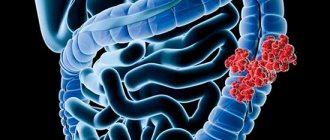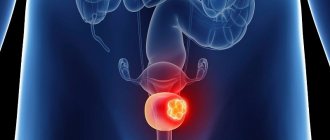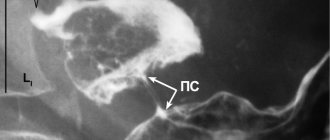Sigmoid colon cancer often does not manifest clinical symptoms for a long time. For this reason, the diagnosis is often made at a late stage of the tumor process. Doctors at the Yusupov Hospital recommend that even with minor manifestations of intestinal discomfort, immediately seek help.
At the Yusupov Hospital, oncologists use the latest methods for diagnosing diseases of the sigmoid colon. Patients are examined using the latest equipment from leading global manufacturers. Laboratory technicians examine blood, feces and other biological materials using high-quality reagents, which allows you to obtain accurate test results.
Surgeons at the Oncology Clinic masterfully perform traditional and innovative surgical interventions. Chemotherapists prescribe patients the most effective antitumor drugs that have minimal side effects. Radiologists conduct radiation therapy with modern devices that allow them to target the pathological focus without damaging the tissue surrounding the tumor.
Causes of tumors
Sigmoid colon cancer originates from glandular epithelial cells. Accounts for 34% of the total number of colorectal cancer cases. In 60% of cases, a malignant tumor is detected in patients aged 40-60 years. Men suffer 1.5 times more often than women.
The high probability of developing sigmoid colon cancer is due to the characteristics of the organ. The sigmoid colon is located on the left side of the abdomen, above the rectum. It has an S-shape. If the movement of contents through the intestines slows down, it remains in the sigmoid colon for a long time. This increases the time of contact of toxic food processing products with the organ mucosa.
Sigmoid colon cancer can develop under the influence of the following unfavorable factors:
- Unbalanced diet - eating large amounts of fatty and meat foods, insufficient consumption of fruits and vegetables, foods rich in fiber;
- Compounded heredity - the risk of developing a malignant neoplasm increases if close relatives had sigmoid colon cancer;
- Chronic inflammatory processes in the intestines - nonspecific ulcerative colitis, diverticulosis, Crohn's disease;
- A sedentary lifestyle, as a result of which the evacuation of intestinal contents slows down;
- Multiple intestinal polyps, which are prone to degeneration into a malignant tumor; Constipation, in which the mucous membrane not only comes into contact with carcinogens for a long time, but is also injured by the solid contents of the intestine;
- Age-related intestinal atony.
Smoking, alcohol abuse, and consumption of foods containing carcinogenic food additives lead to the development of sigmoid colon cancer.
Make an appointment
Epidemiology
Applicable to Russia and the former USSR, one can note the rapid increase in the incidence of diverticular disease. In 1970, the incidence of the disease did not exceed 2-3 per 100 thousand population. In 1979, this number increased almost 6 times. According to data published by the State Research Center in 2002, the number of diverticulosis detected during X-ray examination was 14.2% of all coloproctological patients, and already in 2012 this figure doubled and amounted to 28.8%.
The growth of this disease is clearly visible along with the process of industrialization and urbanization due to changes in people’s way of life, lifestyle and nutrition. A decrease in the amount of dietary fiber consumed, a large amount of carbohydrate foods and consumption of red meat led to a significant jump in cases of diverticulosis.
In contrast, in developing agricultural countries, diverticular disease is characterized by isolated cases, which is determined by the nature of the diet, which includes a significant amount of plant foods.
The aging of society is another reason for the increase in the incidence of diverticular disease. It is noted that under the age of 40 years, the risk of developing diverticulosis varies between 5-10%. Whereas at the age of 60 years, the percentage of detected cases of the disease is already 30%, and by the age of 80 it exceeds 66%.
Thus, diverticular disease was, is and remains a serious problem posing difficult challenges for doctors and patients.
To understand the term diverticular disease, a brief description of the anatomy of the colon is necessary.
Classification
Taking into account the characteristics of tumor growth, oncologists distinguish two types of sigmoid colon cancer: exophytic and endophytic. Exophytic tumors grow into the intestinal lumen. They are protruding nodes on a thick stalk. As the pathological process progresses, sigmoid colon cancer often ulcerates. Bleeding and infection occurs.
Endophytic cancer of the sigmoid colon grows predominantly deep into the intestine. The tumor spreads along the intestinal wall and can cover the intestine circularly. In its center, areas of ulceration appear. Due to the circular growth of sigmoid colon cancer, the intestinal lumen narrows and the movement of feces becomes difficult. This type of growth is most characteristic of sigmoid colon cancer.
Histologists distinguish three types of sigmoid colon cancer:
- Adenocarcinoma originates from glandular epithelial cells. It can be highly differentiated, moderately differentiated and poorly differentiated;
- Mucous (mucosal) adenocarcinoma is a type of poorly differentiated adenocarcinoma, represented by mucinous cells that secrete large amounts of mucus. The tumor grows quickly and metastasizes early;
- Signet ring cell carcinoma of the sigmoid colon is represented by atypical signet ring-shaped cells, which are formed as a result of intracellular accumulation of mucin, pushing the cell nuclei to the periphery. The tumor is aggressive and has an unfavorable course.
Cancer of the recto-sigmoid colon is represented by two forms: scirrhus and adenocarcinoma.
Risk factors
Risk factors and mechanisms of colon polyps are being actively studied. Among the environmental factors, the nature of nutrition is significant, with a predominance of refined foods in the diet, which contribute to constipation and prolonged stasis of intestinal contents. Dysbacteriosis of the colon has some influence on the occurrence of polyps, reflecting a violation of local and decreased general immunity, contributing to changes in the differentiation and regeneration of mucosal cells. The role of concomitant diseases of the biliary system and impaired production of bile acids, which have a mutagenic effect on the mucous membrane, is also noted as a risk factor. Active chronic inflammation and mucosal dysplasia play a certain role in the occurrence of polyps.
Stages
Oncologists distinguish 4 stages of sigmoid colon cancer:
In the first stage of the tumor, the size of the tumor does not exceed two centimeters. The tumor is located within the submucosal layer or mucosa. Regional lymph nodes are not affected by atypical cells.
In the case of the second A stage of cancer, the tumor occupies less than half the circumference of the intestine and does not grow into the wall. There are no metastases in the lymph nodes and internal organs. A cancerous tumor at stage 2B is located in the intestinal wall, but does not extend beyond its boundaries. Oncologists detect metastases in the lymph nodes. There are no distant metastases.
With stage 3A sigmoid colon cancer, the size of the tumor exceeds half the circumference of the intestine. There are no atypical cells in the regional lymph nodes. In stage 3B tumors, regional lymph nodes are affected by metastases.
The tumor in stage 4 cancer blocks the lumen of the sigmoid colon. Hematogenous metastases are detected in other organs. In stage 4 sigmoid colon cancer, nearby organs are affected, and enterovesical fistulas and conglomerates are formed.
Symptoms
At first, sigmoid colon cancer is often asymptomatic or minimally symptomatic, which complicates timely diagnosis. As the tumor progresses, it spreads to nearby organs, giving regional and hematogenous metastases (to the liver, lungs, spine, and less often to other organs).
In the lower part of the intestine - the sigmoid colon - feces are finally formed, water and nutrients are absorbed. With improper nutrition, feces are retained in this segment of the large intestine. The accumulated feces presses on the intestinal walls, as a result of which blood circulation is disrupted and toxic substances enter the body through the walls of the sigmoid colon. Constant constipation negatively affects the entire body. As a result of stagnation of intestinal contents, precancerous diseases, malignant tumors of the sigmoid colon, develop.
For quite a long time, a tumor of the sigmoid colon does not manifest clinical symptoms, which complicates timely diagnosis. The first symptom of sigmoid colon cancer is intestinal discomfort. At first it occurs periodically, and with the growth of the tumor it becomes more pronounced. Later stages of sigmoid colon cancer are manifested by the following symptoms:
- Flatulence, belching, nausea, constipation or diarrhea, pain;
- The appearance of streaks of mucus and blood in the stool;
- Intense, dull or cramping pain that does not depend on food intake;
- Development of intestinal obstruction;
- Abdominal abscess, bleeding, peritonitis (inflammation of the peritoneum).
Patients have diarrhea alternating with constipation. Doctors are often able to palpate a tumor-like formation in the left half of the abdomen. Sometimes the first manifestation of the tumor process is the development of intestinal obstruction. As the tumor progresses, it spreads to nearby organs, giving regional and hematogenous metastases (to the liver, lungs, spine, and less often to other organs).
In patients with sigmoid colon cancer, doctors identify the following symptoms:
- Weakness;
- Fatigue;
- Pale or grayish skin tone;
- Hyperthermia;
- Loss of weight and appetite due to cancer intoxication.
With the development of intestinal obstruction, paroxysmal cramping pain occurs, which is repeated every 10-15 minutes, bloating, gas and stool retention are noted. Possible vomiting. If the intestinal wall is destroyed, peritonitis develops. Stage 4 sigmoid colon cancer with liver metastases is manifested by cachexia (cancer exhaustion), anemia (anemia), jaundice and liver enlargement. When hematogenous metastases appear, symptoms appear that indicate dysfunction of the affected organs.
Make an appointment
How does diverticular disease manifest?
Uncomplicated diverticulosis is characterized by an asymptomatic course - you may not even notice the disease. Diverticula may be an incidental finding during routine examination. In this situation, no special treatment is required. Recommendations include regular medical supervision, a diet high in fiber and low in refined carbohydrates, as well as regular physical activity and weight management.
The difficulty of timely detection of diverticular disease lies in the absence of specific symptoms. The clinical picture consists mainly of cramping pain, predominantly in the left lower abdomen, increased gas formation, unstable stools with a tendency to constipation or alternating constipation and diarrhea. Such complaints are mainly associated with disorders of colon motility.
When visiting a doctor, such patients are usually diagnosed with “irritable bowel syndrome” or “dolichosigma”, the patient is reassured, recommended to perform an ultrasound examination of the abdominal cavity and, after prescribing light therapy, is sent “home”.
However, in case of such complaints, a colonoscopy is mandatory! The above symptoms can be manifestations not only of diverticular disease, but also of many other diseases of the colon, the timely detection of which can significantly improve treatment results.
Figure 3. Colonoscopy. The orifices of the diverticula are visible
The clinical picture of diverticulitis varies significantly. Severe abdominal pain, bloating, lack of stool, may be accompanied by fever, nausea, and vomiting. Such complaints require urgent hospitalization in the coloproctology department, where patients receive antibacterial, anti-inflammatory therapy, and if this treatment is insufficiently effective, surgical intervention may be necessary.
The main cause of inflammation of a diverticulum - diverticulitis - is the ingress of dense feces into it, which are unable to come back out. At this stage, inflammatory changes and the formation of infiltration (compaction) of surrounding tissues occur.
Diagnostics
The diagnosis of a sigmoid colon tumor is made by oncologists at the Yusupov Hospital taking into account the medical history, complaints, objective examination data and the results of additional studies. The most informative methods for sigmoid colon cancer are endoscopic methods (sigmoidoscopy and colonoscopy). They allow you to visually assess the volume and location of the tumor and take material for subsequent histological examination.
In the process of examining patients with suspected sigmoid colon cancer, doctors at the Yusupov Hospital use irrigoscopy (X-ray examination using a barium suspension) and stool analysis for occult blood. To detail the stage of the tumor process, magnetic resonance and computed tomography are performed. All instrumental research methods are performed using the latest equipment from leading manufacturers in the USA, Japan and European countries.
Other diagnostic techniques are used to detect metastases:
- Ultrasound examination of the abdominal organs;
- X-ray of the spine;
- Chest X-ray.
Oncologists at the Yusupov Hospital make the final diagnosis based on the results of histological examination. Differential diagnosis of malignant neoplasms of the sigmoid colon is carried out with precancerous and inflammatory bowel diseases, fixed tumors of the retroperitoneal space and mobile neoplasms of the mesentery.
Complex therapy
Oncologists at the Yusupov Hospital provide combined treatment for malignant tumors of the sigmoid colon.
It includes surgery, radiotherapy and chemotherapy. The leading role is given to surgical treatment, which is aimed at radical removal of the tumor. The extent of surgical intervention depends on the extent of sigmoid colon cancer. In the early stages of the disease, endoscopic techniques are used in some cases. For this purpose, resection of the sigmoid colon is used. In case of widespread tumor processes, surgeons perform resection of the sigmoid colon with a section of the mesentery and nearby lymph nodes. The affected area of the sigmoid colon is removed along with five centimeters of intact intestine located above and below the tumor. Surgery for sigmoid colon cancer can be one-stage or two-stage. When performing one-stage operations after tumor removal, the surgeon restores intestinal continuity by performing an anastomosis. In advanced cases, the intestine is resected and a colostomy is formed. The integrity of the intestine is restored several months after the first operation.
Surgery can be typical, combined, extended or combined. A typical operation involves resection of the area of intestine containing the tumor. A combined treatment method is used if it is necessary to perform surgery on the cancer-affected segment of the intestine and other organs into which the tumor has grown. Extended surgery is performed when the tumor grows or there are synchronous neoplasms. A combined operation involves removing the affected segment of the intestine along with other organs due to concomitant diseases.
In the presence of cancer metastases, doctors at the oncology clinic administer chemotherapy. Treatment with antitumor drugs for sigmoid colon cancer after surgery is used with caution - in some cases it can cause negative results. Most often, the use of chemotherapy is advisable for inoperable tumors - it helps to reduce the size of the tumor. Sigmoid colon cancer does not respond well to radiation treatment. Radioactive rays can damage normal tissue, so this method is not used to treat sigmoid colon cancer.
In advanced cases of cancer, palliative therapy is carried out to reduce pain and ensure intestinal patency. Sometimes emergency surgery is performed for sigmoid colon cancer. They are aimed at sanitizing the abdominal cavity in case of peritonitis and eliminating intestinal obstruction.
Possible complications
Possible complications:
- bleeding due to inadequate hemostasis;
- failure of postoperative wound sutures or anastomosis;
- infectious complications (life-threatening conditions such as peritonitis and sepsis may develop);
- dynamic intestinal obstruction (intestinal paresis);
- adhesive disease;
- postoperative hernia.
A sigmoidectomy is a major surgical procedure. However, if the operation is performed correctly by qualified surgeons and the patient follows all recommendations, it is possible to achieve a good quality of life for the patient after resection.
Nutrition after surgery
After surgery on the sigmoid colon, patients at the Yusupov Hospital are provided with dietary nutrition. The chefs prepare dishes from quality ingredients. They contain a sufficient amount of vitamins and minerals. The menu includes kefir, yogurt, bifido products, fresh vegetables and fruits. All dishes are prepared using gentle technologies: steamed, boiled, baked in the oven or grilled. If indicated, the food is crushed. Patients eat regularly, in small portions.
During the rehabilitation process, the patient should follow certain rules:
- eat only fresh foods;
- products must contain a sufficient complex of vitamins and minerals;
- reduce meat consumption to a minimum;
- consume kefir, yogurt, and bifido products more often;
- eat more fresh vegetables and fruits;
- include cereal porridges and products made from wholemeal flour with bran in the menu;
- periodically include boiled or steamed sea fish in the menu;
- Take food in crushed form, chew thoroughly;
- do not overeat, eat small meals and regularly.
Rehabilitation period
The rate of recovery after surgery depends on the volume of intervention performed and the general condition of the body. The rehabilitation period is also affected by the patient’s compliance with the medical and protective regime.
For the first day of the postoperative period, the patient is in the intensive care unit. Antibacterial, anti-inflammatory and analgesic drug therapy is carried out. Chemotherapy drugs may be administered according to indications.
Diet after resection:
- 12-24 hours after surgery, drinking water and unsweetened tea is allowed;
- It is necessary to expand the diet gradually. During the first week, the diet should consist only of liquid and pureed food;
- gradually you can include a small amount of solid foods in the menu;
- the patient will eat small portions 5-6 times a day;
- after a month, the patient can gradually return to his usual diet, but completely eliminate fatty, smoked, spicy and alcohol;
- with a properly selected diet there should be no digestive disorders.
To speed up rehabilitation, patients are recommended to engage in therapeutic physical education. The physiotherapist selects the volume and type of exercises individually for each patient.
Forecast
The survival prognosis of patients with sigmoid colon cancer depends on the histological type of the tumor, the level of cell differentiation, the prevalence of the malignant process, the presence of concomitant diseases and the age of the patient.
The average five-year survival rate is 65.2%. A more optimistic prognosis after surgery for adenocarcinoma of the sigmoid colon, since the tumor grows slowly and practically does not metastasize. When sigmoid colon cancer of the first stage is detected, 93.2% of patients overcome the five-year mark, the second - 82.5%, the third - 59.5%. 8.1% of patients with stage 4 sigmoid colon cancer survive up to five years. Therefore, consult a doctor when the first signs of intestinal dysfunction appear.
To establish an accurate diagnosis in the early stages of sigmoid colon cancer, when the first signs of intestinal disorders appear, call the Yusupov Hospital. After a comprehensive examination, if the diagnosis is confirmed, oncologists will provide adequate therapy. After treatment, doctors at the oncology clinic conduct clinical observation, the purpose of which is the timely detection and treatment of early metastases. This makes it possible to improve the quality and increase the life expectancy of patients diagnosed with sigmoid colon cancer.
Make an appointment
Which doctor should I contact?
Diverticulosis is a gastrointestinal disease, and treatment is most often carried out by a gastroenterologist. The primary task of the doctor is:
- Excluding diagnoses with similar symptoms;
- Purpose of examination;
- Determining a strategic approach to treatment.
During the treatment process, you may need to consult other specialists: a proctologist, a surgeon, a therapist, a pediatrician and geriatrician, an endoscopist and a nutritionist.
